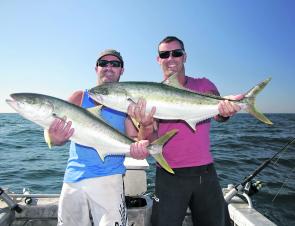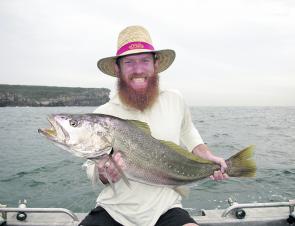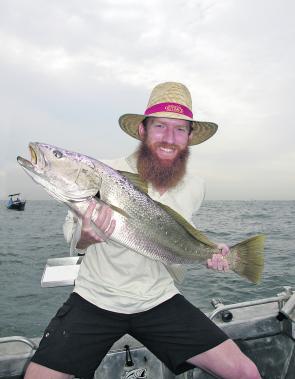Sydney Harbour is going nuts at the moment and is well and truly making up for the season’s slow start. Hopefully this is an indication that the activity will run late and we should be experiencing good fishing well into May, possibly even June.
The highlights lately have been good numbers of both big and small kings, and school mulloway to 12kg. There has also been plenty of amberjack and samsonfish mixed in amongst them.
Tactics need to change now, as will the kingies’ holding positions. You will still get them around places like the wedding cakes and other navigation markers, but they have become fussy, requiring a bit of berley and smaller, lightly weighted baits. Their interest in lures is slowing down as well. There’s more fish concentrated around the heads and Sow and Pigs as they commence their migration out to sea. Best bait is still squid, but make good use of the prime baits like the heads and guts, and cut the tubes into smaller strips. Baits should be presented on lighter gear, lighter leaders, less sinker, smaller hooks and down a cube trail.
If you want to target the larger kings, use whole live squid around the Spit Bridge, North and South Head, and the deeper channel markers like Neilson Park, Clifton Gardens and Rose Bay. Live gar work pretty well at this time of year, especially on the big fish. Gars are swarming all over Sow and Pigs right now. You can catch them with a bit of surface berley and a 12-14 hook under a light quill float baited with small pieces of prawn or pilchard gut.
If you have any gar left over at the end of the day, they make an excellent feed. Cut off their heads, gut and scale, tenderize them lightly with a rolling pin or a meat hammer. Dip them in egg and flour and deep-fry. You can eat them whole, as the bones will have become crisp from the frying.
To use them as bait, swim them out on a 4/0-6/0 Octopus pattern pinned under the lateral line through the fleshy area behind the gut cavity. Pinned above the lateral line, the weight of the hook will eventually drag them upside down and kill them. Pinned beneath the lateral line will keel them in a natural position. Swim them out either unweighted or 1m ahead of a small bobby cork. The take is usually in the form of a spectacular surface strike.
Big kings have already started to show and we have taken a few to 10kg in the lower reaches. The obvious spots to look are the deepwater locations around structure. From my experience, kings and mulloway don’t like to be in the same spot at the same time, although they do like the same type of habitat. I’ve had a run of mulloway replaced by a run on kings on more than one occasion, with very little crossover. There’s probably a territorial battle going on down there and I’d put my money on the kings generally winning.
The exceptions to this are areas that are only used as feeding grounds rather than holding grounds, where you will find kings by day and mulloway at night. These are usually in shallower water (10-20’) than you would traditionally target holding fish, and will work best either very early morning or late arvo (kings) or night (mulloway) and usually have kelp beds nearby.
Holding spots will be deep (20-60’) and have some structure, preferably with shade (buoys, jetties, bridges or rock ledges) and some current.
Harbour holding spots for big fish include: inner North Head, Neilson Park, the mouth of Rose Bay, particularly around Shark Island (please note that most of this area is a no anchor zone and is therefore only suitable to drifting in reasonable weather), inner South Head, Wedding Cakes and Seaforth, VB Reef and Pickering Point in Middle Harbour. These are spots that you would typically fish through the day.
Feeding spots include: Middle Head, Fairlight, Sow and Pigs, Washaway Beach, Obelisk Beach and Quarantine. These are good early morning, late afternoon and night spots.
Sydney is presently in the grip of mulloway fever, spurred on by 1 of the best seasons in many years. They are taking them in the upper estuaries, they are taking them in the lower harbour, and they are taking them on the beaches.
They are probably the hardest of all fish to crack the code on for consistent success, but here are a few tips that should make it a bit easier.
There is no doubt that the turn of the tide — preferably high, but low works as well — is the pick. If you can find these tides to coincide with low light periods, even better.
Mulloway are different to kings who hang around structure for reference, food and shade. They actually like to get inside the structure for security. Don’t always assume that it needs to be deep either. I know of at least 1 patch of washy, gnarly bommies, within casting distance of shore, that produces fish up to 18kg and sits in less than 15’ of water.
What about when they move well upstream into the mangrove estuaries where there is very little structure? This makes things a bit easier in regards to all tide access. They will be found sitting on the bottom in the deepest holes, but in generally open water. This means that you can reach them with a bait or lure through any stage of the tide. Of course, you will still do better during those tide changes when they are actively feeding. Bridges are a major source of artificial structure in an environment where there would otherwise be none. These are prime spots in the upper reaches, especially for lure chuckers.
Soft plastics have had a huge influence in the success of luring mulloway in recent years. Their main attribute over hardbodies is their ability to maintain contact with the bottom. They seem to be most effective in the shallower spots (down to 40’). Night fishing around the various bridges with poppers can also be very effective.
There has always been a lot of debate about best mulloway baits. For me, it’s unquestionably squid. It doesn’t have to be alive, in fact I think cut baits might even work better, but it has to be fresh. Other baits work well too, but once again freshness is the key. Generally, this means catching your own.
The worst week is the week after and including the night of the full moon. The best weeks are the lead up to the full and new moon. It’s no co-incidence that the perfect tides during these periods fall early morning and late afternoon in low light conditions.
Two major factors influence mulloway movement into the harbours and rivers in the cooler months. First is the return of the mullet from their spawning run to the beaches in May. Then the big squid move into the coastal kelp beds for breeding. This is good news because the squid, so critical for bait, are big and easy to catch.
To a lesser degree, May/June is also a time for big and abundant tailor in the harbours. May, June and July are your prime months.
At this time of year, your best bites will occur when the wind is blowing nor’ west and then swings sou’ west or south. In other words, just before a front. It’s a narrow window of opportunity. It doesn’t seem to matter too much whether it’s overcast or bright and sunny. Of course, this is not the only time they feed; it’s just the best.
Reads: 1361
Quality kingfish like this pair should be on the chew until June.

La Nina rains of the last 3 years have brought on some of the best mulloway fishing in a long time.

La Nina rains of the last 3 years have brought on some of the best mulloway fishing in a long time.

Amberjack love warm water and squid in equal amounts.




